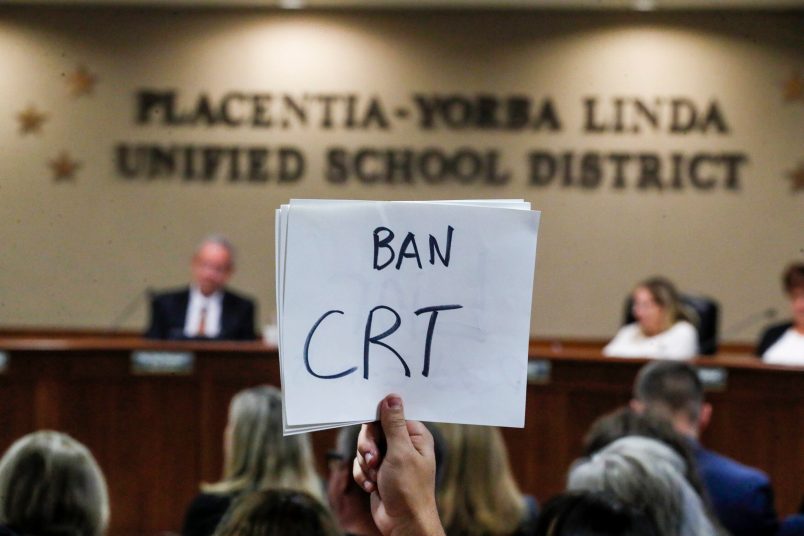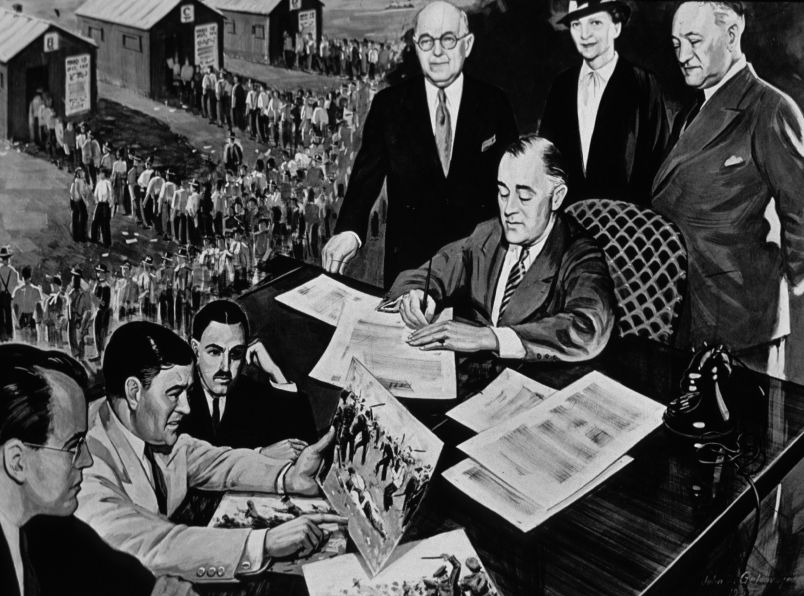This article is part of TPM Cafe, TPM’s home for opinion and news analysis.
The outpouring of protest following the death of George Floyd last year made it painfully obvious that we are far from the postracial dream of not long ago. Those intense divisions have moved from the streets to the classrooms, as half the states have passed or are considering legislation restricting the study of critical race theory. With Governor Doug Burgum’s signature, North Dakota becomes the latest state to ban CRT in public schools. Conservative leadership has made the issue into a cause célèbre for the Republican Party and the culprit for contemporary disharmony. Teaching the centrality of race in U.S. history, they say, foments hatred of America. Structural racism is a thing of the past, they argue. Contrary to what liberals conjure, America is a just and meritorious country.
These policies are having real effects. It cost the job of one high school principal in Texas, and pundits in Virginia turned the governor’s race into a referendum on CRT. Criticism against “woke” politics and the raucous debate surrounding the New York Times’s 1619 Project point to the key question lingering on this stage: How should the nation remember slavery?
Harvard sociologist Orlando Patterson famously called enslavement a kind of “social death,” which made its subjects into people without legal recourse or community belonging. It was an economic and racial system that structured modernity as Europeans crossed the Atlantic to the Western Hemisphere. Saidiya Hartman, Professor of English at Columbia University, argues that there is an “afterlife” of slavery, that emancipation did not bring liberation for African-descended people but rather an everlasting battle against devaluation and fractionalized personhood, the legacies of which are found in the chants of Black Lives Matter demands and CRT denouncements.
A more pressing question seems to center on white people’s discomfort with the country’s past, for most of the CRT complaints do not come from communities of color. One reason for this detachment is the value white people put on their immigrant forebears that arrived after slavery’s abolition. The impulse can lead to disavowal: if their ancestors came to the United States after emancipation, they need not identify with, much less atone for, the sins wrought by the “peculiar institution.” Even the first African American female secretary of state, Condoleezza Rice, went on “The View” and lamented the persistence of white guilt.
But this misses the larger picture, which is not that white people should feel guilty for slavery (though there are families of multiple racial backgrounds that have direct links to slaveholders) but rather America, white people included, must be reminded of the glacial afterlives of slavery, without which the country as we know it would not exist.
Too many people receive educations that isolate slavery as a Southern experience. Yet enslaved people were omnipresent in the North during colonial times and existed in diminished ways into the early republic and beyond. The Emancipation Proclamation of 1863 only freed slaves in states rebelling against the Union. When states ratified the Thirteenth Amendment abolishing slavery in 1865, slavery still existed in New Jersey.
Even as the North severed its own practice of slavery, it did not extricate itself from the immense wealth and material benefits bondage brought. By the time of the Civil War, the South produced two-thirds of the world’s cotton. Northerners wore clothes woven from the cash crop picked by women and men in chains. Northern banks provided securities that helped slavery expand. Yankee insurers doled out policies that protected slaveholders’ human chattel.
Without the wealth built on the backs of slaves, the more than 20 million immigrants arriving between 1880 and 1920 may have opted elsewhere, for the country would have been different from the one that slavery helped birth. What might the United States have looked like had it lacked the industrializing advancement after a civil war caused by slavery? Descendants from those immigrants might ask ourselves: would we even exist without it?
Then there is the vast influence of the millions enslaved. If we look historically, there is a cultural lineage that dates to the plantation, a line we can draw from spirituals to ragtime, to blues and country western, and finally to rock and roll and pop music. The tradition of African American song is the radiant thread of this fabric. We would not have the minstrel music of Stephen Foster, popping melodies of Scott Joplin, or the melancholic dirge of blues performer Ma Rainey without the heinous pretext of bonded labor.
Make no mistake: celebrating the artistic legacy does not mean applauding the history of enslavement. But it does connect the nation—white people included—to a history that critical race theory can illuminate. Rock and Roll, for example, came from Black provenance but became associated with white folks. The music of Elvis Presley and Mick Jagger not only contains these compositional traces but performative ones as well. This is to enter into the long history of blackface minstrelsy and the custom of the white body gesticulating in racialized mimicry. It is the borrowing and imitating of bodily movements culled from American blackness that make white blues and rock performers indebted to Black cultural production. One may think of the young Mick Jagger performing “Honky Tonk Women” or when Elvis was filmed from the waist up on his third appearance on the Ed Sullivan Show, his style of dance deemed too risqué for Sullivan’s white middlebrow audience.
By the 1940s, American music differentiated itself into pop, rhythm and blues, and country-western. These became distinct genres according to racial communities. Who performed and listened to the music was more important than the music’s harmonies and rhythm. Thus, Elvis fell into the rock category, whereas Chuck Berry became an R & B celeb. Meanwhile “Hillbilly” became “country-western,” bringing stardom to individuals like Hank Williams. Written ages ago, in the routes and roots of nineteenth-century Americana, this story in all its beauty and glory cannot be told without reference to America’s most ignoble institution.
That history crops up in CRT conversations. It is true that right-wingers are looking to sprout new voters by revamping education to validate their truths. Their sights are set not only on K-12 schools but on college campuses as well, with states like Georgia and South Carolina challenging academic tenure of the professoriate.
But attempts at such a reeducation are destined to fail, for the country cannot spin or vote its way out of this history. Slavery’s afterlives are omnipresent in our society, in the cultural scripts of our violence and entertainment.
John A. Gronbeck-Tedesco is an associate professor of American Studies at Ramapo College of New Jersey.









